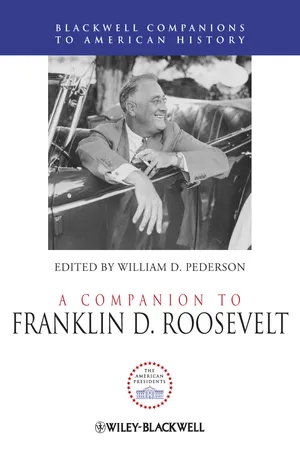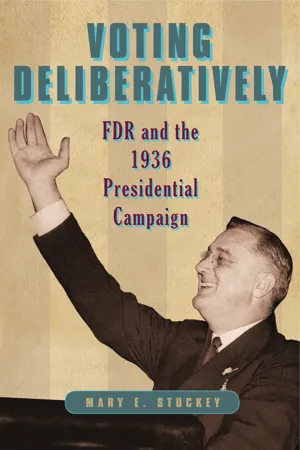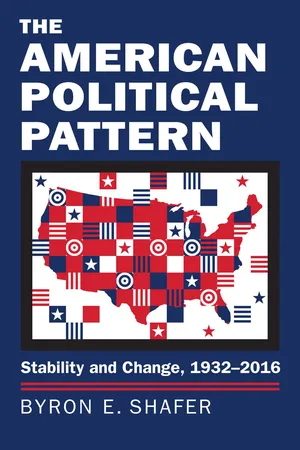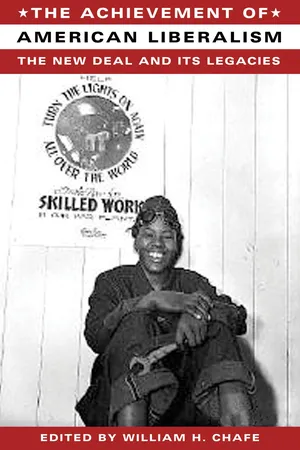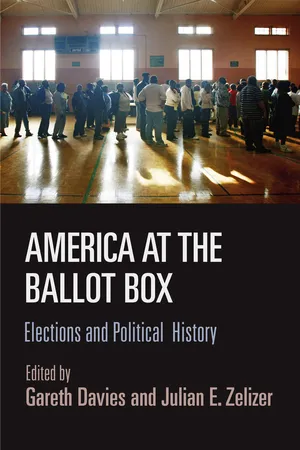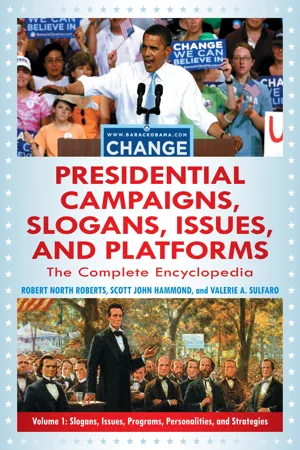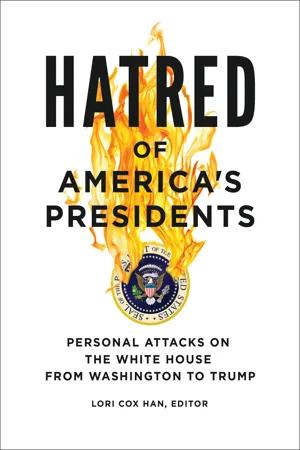History
1932 Presidential Election
The 1932 election in the United States marked a significant shift in political power, with Franklin D. Roosevelt winning the presidency in a landslide victory over incumbent Herbert Hoover. This election took place during the Great Depression, and Roosevelt's New Deal policies aimed to address the economic crisis, making it a pivotal moment in American history.
Written by Perlego with AI-assistance
Related key terms
1 of 5
10 Key excerpts on "1932 Presidential Election"
- eBook - ePub
Delivering the People's Message
The Changing Politics of the Presidential Mandate
- Julia R. Azari(Author)
- 2014(Publication Date)
- Cornell University Press(Publisher)
The partisanship, frequency, and defensiveness of Hoover’s mandate rhetoric resembled that of the partisan era that began forty years later. The emphasis on “pledge politics” and the use of the mandate to respond to challenging questions anticipated how a diverse group of later leaders—Nixon, Carter, Clinton, George W. Bush, and Obama—would employ mandate rhetoric. In contrast with Hoover’s successors who departed quickly from this mold of mandate claiming, presidents in the partisan era have employed it as a rhetorical norm. Political and institutional conditions account for this difference.Interpreting the 1932 Election
The historical significance of the 1932 election can hardly be mistaken. Herbert Hoover was turned out of office and his Democratic rival, Franklin Roosevelt, was elected with more than 57 percent of the popular vote. The new president offered a “New Deal,” which contained a mix of new and old ideas, packaged in terms of national values as well as economic necessity.51 Roosevelt also engineered changes in the Democratic Party’s nomination rules, was the first president inaugurated under the Twentieth Amendment (which moved Inauguration Day from March to January), and became the first (and last) president elected to more than two terms.In the evolution of mandate rhetoric, the FDR presidency was also a turning point. FDR neither embraced Wilson’s vision of the party mandate, nor did he use mandate logic frequently when promoting New Deal policies. Both the 1932 and 1936 elections could easily have qualified as party landslides, yet Roosevelt’s mandate rhetoric reveals a more complicated picture. In 1933, when his position was strong and national crisis bolstered the legitimacy of his initial agenda, mandate rhetoric was sparse. After the 1936 election, Roosevelt invoked the election mandate in the context of an institutional clash: the “court-packing” plan of 1937.Even with the Great Depression as a backdrop, the meaning of the 1932 election was contested. Newspapers offered a range of interpretations. The superintendent of the Anti-Saloon League, Scott McBride told the New York Times, “If the party misinterprets the election as a mandate for beer and a demand for repeal it need not hope to succeed. Most of the wet Democrats who won in this landslide were elected because they were Democrats and not because they were wets.”52 Coverage of the election offered a number of possibilities for its meaning: some emphasized the Democratic victory; some gave the numbers a central place in the narrative; and still others directed attention toward voter anger, suggesting a negative referendum on the incumbent administration rather than a positive one on Roosevelt or the Democrats.53 Charles Hurd reports in the New York Times that “7,000,000” cast their votes in favor of the New Deal and emphasizes both the magnitude of the victory and the party and policy implications of the result, suggesting that the “Democratic triumph entails an implied command to solve the problems of economic dislocation, of prohibition, and the foreign affairs of the United States as they are related to war debt and tariffs.”54 By contrast, the Wall Street Journal questions the partisan and ideological terms in which the victory had been cast by the president and sources sympathetic to him; an article with the subtitle “Strange Bedfellows Made Up the Mass Movement Which Elected Roosevelt” questions Roosevelt’s claim to a “victory of liberal thought” in the postelection radio address and further ponders the role of electoral majorities in the design of the Constitution.55 - eBook - ePub
- William D. Pederson(Author)
- 2011(Publication Date)
- Wiley-Blackwell(Publisher)
Chapter Five THE ELECTION OF 1932 Donald A. Ritchie The process of deciphering the 1932 election began as soon as the campaign had ended. It quickly became a truism that the Great Depression had doomed Herbert Hoover’s chances of reelection and paved the way for Franklin D. Roosevelt’s presidency. Less attention was therefore devoted to why Roosevelt won than on whether or not his campaign adequately prepared the nation for his New Deal agenda. By all accounts, the 1932 election marked a watershed in American politics. The Great Depression profoundly shook American voters, forcing them to reexamine their political allegiances and expectations for the federal government. After being the dominant political party since the Civil War, Republicans were dethroned and Democrats became the majority party for most of the next half century. Herbert Hoover, who had won the presidency in a landslide four years earlier, lost it in an even greater electoral avalanche. Franklin Roosevelt swept into the presidency promising a new deal for the American people. Democrats added 99 seats in the House and a dozen new senators to give them overwhelming control of Congress, and a readiness to follow the new president wherever he led, to get the nation out of the economic crisis. Citizens’ expectations for the federal government expanded and new programs more directly connected the government to their daily lives. The relevant literature began a year before the election when Ernest K. Lindley, a New York Herald Tribune reporter who covered Roosevelt as governor, published an influential campaign biography, Franklin D. Roosevelt: A Career in Progressive Democracy (1931: 7–8, 355). Lindley denied that Roosevelt had solicited him to write the book, but its sympathetic assessment helped to boost his candidacy. In a second edition, released after the election, Lindley added a chapter on the Democratic nomination, reminding readers that there had been nothing inevitable about that outcome - eBook - PDF
Voting Deliberatively
FDR and the 1936 Presidential Campaign
- Mary E. Stuckey(Author)
- 2015(Publication Date)
- Penn State University Press(Publisher)
Going into the 1936 campaign, then, the nation had been long consumed with conversations about the damaged economy and how best to repair it, about the national government and how much power to give it, and about the nation itself and how best to lead it. Roosevelt had a wide-ranging, if not always coherent, set of answers to these questions. His various opponents had a vari- ety of objections to his policies and a broad range of alternatives. The election was, therefore, practically a textbook case of the possibilities for deliberation in a democratic republic. It was a referendum on the president and a test of the relationship he had forged with the American people. It was also a proving 14 voting deliberatively ground for his theories of governance—theories that turned on the new cul- tural emphasis on science and efficiency, manifested in public-opinion polls; that depended on the mobilization of the mass public; that understood the pub- lic as composed of economic and ascriptive groups; and that sought to unify those groups through an avowedly nationalistic set of rhetorical appeals. The 1936 election validated both these theories and the president’s leadership and proved to be the pivotal moment in the creation of the New Deal coalition and the practice of American elections. The 1936 Campaign We think of presidential campaigns as confined processes, engaged in between candidates from two major parties who seek to influence voters in specifically targeted states. They are, however, also more than that. They are national con- versations about the policies, parties, and people who will govern the nation, and they involve members of the mass public, organized by party but also along the lines of interest groups and demographics, as well as unaffiliated and sometimes even uninterested citizens. Elections are opportunities to engage in debate as well as to make decisions. - eBook - ePub
The American Political Pattern
Stability and Change, 1932-2016
- Byron E. Shafer(Author)
- 2016(Publication Date)
- University Press of Kansas(Publisher)
Either way, the remainder of the High New Deal Era was to confirm, less grandly but more explicitly and directly, that the general public was fully capable of adjusting its voting behavior to take account of policy outcomes and to pass judgment on them. Thus the presidential election of 1936 would confirm that the general public could pass a solid positive judgment on the policy products of the overall New Deal, just as the midterm election of 1938 would confirm that this public could pass equally negative judgments when it felt that the program was not producing. Accordingly, despite alternative abstract possibilities and despite actual concrete disputes among professional experts about the precise dynamics that made the election of 1932 pivotal in terms of party balance in the United States, most of the disputants, both active partisans and professional analysts, appear prepared to accept three overall summary judgments about the arrival of a new balance in American society after 1932 : While scholars might continue to debate the precise point at which a new majority could be said to have been institutionalized, that is, converted into a majority of Americans who would reliably call themselves Democrats rather than Republicans, it would be hard to find any voices ready to argue that the Republicans were as strong in the thirty years after 1932 as they had been in the thirty years before, and/or that the Democrats remained as weak. A serious party rebalancing did follow in the wake of the 1932 Presidential Election. At the same time, it was events of the day rather than previously established party programs that propelled this huge partisan change. John W. Davis had offered a Democratic policy program in the presidential campaign of 1924, Alfred E. Smith had offered another in the campaign of 1928, and Franklin D. Roosevelt offered a third, however ambiguous, in the presidential campaign of 1932 - eBook - PDF
The Achievement of American Liberalism
The New Deal and Its Legacies
- William H. Chafe, William Chafe(Authors)
- 2002(Publication Date)
- Columbia University Press(Publisher)
The modern Democratic Party, observers agree with near unanimity, emerged from the trauma of the Great Depression. For a twenty-year mo-ment in history, beginning with Franklin Roosevelt’s landslide victory over Herbert Hoover in 1932, it dominated American politics and served as a ve-hicle for an enormous social transformation that was abetted by an un-precedented growth in the functions and institutional structure of the na-tional government. What with the Depression, World War II, the onset of the Cold War, and the social restructuring that accompanied these phe-nomena, it seems natural enough to call these two decades a watershed in American history. 1 The Democratic high tide, however, might equally be considered a peak in which a long-established political party, with a polyglot constituency and an amorphous policy direction, displayed unexpected resources to lead the American nation through one of the most critical periods of its history. The special character of this era in Democratic history is illustrated by a telling statistic: in 1932, Roosevelt was the party’s first candidate for president since Franklin Pierce (in 1852) to win more than 50 percent of the total popular vote. FDR would do it four times. Only two Democrats have managed it since—Lyndon Johnson in 1964 by an enormous margin and Jimmy Carter in 1976 by a scant half a percent. To an enormous degree, the Democratic success of the 1930s and 1940s was less a matter of national identity and or-ganizational strength than the personal charisma and strong leadership of one president—who in the end valued policy achievement over party. 2 HIGH TIDE: ROOSEVELT, TRUMAN, AND THE DEMOCRATIC PARTY, 1932–1952 Alonzo L. Hamby Begun in the 1790s as an alliance between southern agrarians and north-ern city politicians, the Democratic Party could locate both its greatest strength and greatest weakness in the diversity of its adherents. - eBook - ePub
America at the Ballot Box
Elections and Political History
- Gareth Davies, Julian E. Zelizer, Gareth Davies, Julian E. Zelizer(Authors)
- 2015(Publication Date)
- University of Pennsylvania Press(Publisher)
If the New Deal’s permanence was already largely secure, then FDR’s nomination, like that of Willkie, certainly helped to embed it further in American political culture. This is one of the respects in which the 1940 election not only provides a convenient way of taking the national political pulse at the end of the New Deal decade; also, this campaign, like many others considered in the present volume, changed American politics. That Roosevelt was the nominee ensured that the fall campaign would in substantial measure be fought over his record in office. Given the lowering clouds of European war, however, the leadership he had displayed in response to the great emergency of the Depression would inevitably be viewed through the prism of the ever-deepening global crisis. Had FDR displayed precisely the skills the nation needed in this new hour of need? Or did the record of his first two terms, and his decision to seek a third, disclose dictatorial instincts that left him peculiarly ill-equipped to defend American democracy?To a greater degree than historians sometimes recognize, Roosevelt had often resisted the conservative trajectory of the late 1930s. True, he had suffered big defeats, and he sometimes exhibited a certain demoralization and frustration in their wake. But none of the president’s principal defeats had been complete, whatever the headline story. Most familiarly, while the effort to pack the Supreme Court had been a fiasco, in its wake the Court had reformed itself, starting to construe the Constitution more broadly, in a way that left the New Deal newly secure. And then, between 1937 and 1940, Roosevelt—having made no nominations at all during his first term—was able to appoint no fewer than five New Deal justices to the Court. Spluttering with indignation at what they saw as frankly partisan and ideological appointments, conservative Republicans certainly did not feel themselves to be in control at these moments—and FDR’s continued political authority was evident from the way conservative Democratic senators went along with the selections of these strong New Dealers, close associates of the president.21 The jurisprudential impact of these appointments was felt almost immediately, most notably in the Carolene Products case and Palko v. Connecticut , which saw the emerging Roosevelt Court signal its new interest in civil liberties and civil rights. Little noticed at the time, and presaging an extension of the reform impulse to encompass matters that were of little concern to FDR, this was of course a development with the most profound long-term implications.22 - eBook - ePub
Presidential Campaigns, Slogans, Issues, and Platforms
The Complete Encyclopedia [3 volumes]
- Robert North Roberts, Scott John Hammond, Valerie A. Sulfaro(Authors)
- 2012(Publication Date)
- Greenwood(Publisher)
Their confidence, events proved, was utterly justified. When the election came, the results were no less than stunning. Roosevelt shattered every electoral record, winning 28.7 million total popular votes, amounting to 60.8 percent of the entire popular vote cast (breaking the old record set by Warren Harding in 1920 and eventually exceeded by only one other election—Lyndon B. Johnson in 1964), and taking 523 electoral votes, or 98.5 percent (a percentage of the Electoral College exceeded only by George Washington and James Monroe before the rise of the modern two-party system and the broadening of the franchise), leaving Landon with just 8 electoral votes from two states, Vermont and Maine. Roosevelt’s margin of victory of 24 percent was the third highest in history (exceeded only by Harding in 1920 and Calvin Coolidge in 1924). Impressively, Roosevelt won at least 60 percent of the vote in 30 states. Landon’s approximately 16,700,000 votes represented around 38 percent of the electorate, the remaining votes going to the populist Union Party (their candidate, William Lemke of North Dakota winning just over 930,000 votes), the Socialist Party (campaign veteran Norman Thomas, in his third election, winning just under 188,000 votes, a poor showing for the Socialists who at one time enjoyed a promising position as a growing third party), and the Communist Party (scarcely managing 79,000 votes for their obscure candidate, Earl Browder).The diverse Roosevelt Coalition that was forged in the election of 1932, and somewhat foreshadowed in the Smith campaign of 1928, had not only held its base, but also expanded its reach. For the first time in history, for example, the majority (in this case, 71%) of voting African Americans cast their votes for a Democrat. More importantly, the New Deal programs that Roosevelt and the Democratic Congress established were earnestly embraced by a substantial majority of the American electorate, signaling that a dramatic change had indeed occurred and taken root in the way in which the role of the federal government was understood by the majority of American citizens. The 1930s would continue to be marked by hardship at home and ever-more menacing dangers abroad; but for the moment, Franklin Roosevelt was the most successful politician of his time, and the Democrats enjoyed unprecedented power throughout the federal government.Additional Resources
The American Presidency Project (http://www.presidency.ucsb.edu/ws/index.php?pid=29596#ixzz1IfGCKPvm ).Brands, H. W., Traitor to His Class: The Privileged Life and Radical Presidency of Franklin Roosevelt (New York: Doubleday, 2008).Brinkley, Alan, “1936,” in Arthur M. Schlesinger, Fred L. Israel, and David J. Frent, eds., Running for President: The Candidates and Their Images - eBook - ePub
Hatred of America's Presidents
Personal Attacks on the White House from Washington to Trump
- Lori Cox Han(Author)
- 2018(Publication Date)
- ABC-CLIO(Publisher)
Franklin Delano Roosevelt was born on January 30, 1882, in Hyde Park, New York. He married Eleanor Roosevelt (his fifth cousin, once removed) in 1905 and had six children, one of whom died in infancy. On April 12, 1945, at the age of 63, Roosevelt died of a massive cerebral hemorrhage while in Warm Springs, Georgia. On November 8, 1932, Roosevelt (also commonly known by his initials of FDR) was elected as the 32nd president of the United States, defeating the incumbent president, Herbert Hoover. In the 1932 election, Roosevelt won 472 electoral votes (57.4% of the popular vote) and carried all but six states. He would win reelection as president three more times. In 1936, he defeated Alf Landon decisively by winning 523 electoral votes, 60.8% of the popular vote, and all but two states. Roosevelt broke the two-term precedent in 1940 by defeating Republican nominee Wendell Wilkie, 57.4% to 44.8%. Although the popular vote was narrower that year than in his 1936 triumph, he comfortably won the Electoral College, 449–82, and carried all but ten states. Roosevelt’s final presidential campaign came in 1944, when he defeated Thomas Dewey by a slightly smaller margin than from four years previously, 53.4% to 45.9%. He won easily in the Electoral College, however, claiming 432 votes to Dewey’s 99 and carrying all but 12 states.A CONSEQUENTIAL PRESIDENCYMany Americans harbored passionate feelings about Roosevelt and his presidency—both positive and negative—because of the unparalleled length of his time in the Oval Office and because his policies made significant changes in how the United States addressed important matters of both domestic and foreign policy. The strongest base of opposition was probably among conservative southern Democrats, who saw Roosevelt’s progressive “New Deal” program as a short-term response to the Great Depression (with a return to the status quo once the crisis passed). Some of the more conservative senators like Harry Byrd and Carter Glass of Virginia, Cotton Ed Smith (South Carolina), and Millard Tydings (Maryland) soon realized, however, that Roosevelt’s plans would fundamentally change the country and their party in ways that they deeply opposed.Following significant policy defeats in 1937 and 1938, conservative Democrats were joined by Republicans who opposed much of Roosevelt’s domestic program. Some conservative critics even charged that under Roosevelt, communists were infiltrating all aspects of American life. This paranoia reached the point that the House of Representatives created the Committee on Un-American Activities in 1938 specifically to investigate the threat of communism in America. This committee was initially placed under the leadership of conservative representative Martin Dies (D-TX). Under his supervision, the committee eventually evolved into a weapon for conservatives to wield against the New Deal, which was depicted as making America more susceptible to communism. As the 1930s drew to a close, concerns about America’s role in the world provided another policy issue that would drive hatred of Roosevelt. Specifically, the nation struggled to reconcile its desire to help Europe resist fascism with the pull of isolationism. Underlying both of these broad lines of attack on Roosevelt was anti-Semitism, for many of Roosevelt’s critics believed that Jews exercised undue influence on the administration. Despite the hatred of some political elites, however, Roosevelt remained a generally popular political figure. - eBook - ePub
US Presidential Elections and Foreign Policy
Candidates, Campaigns, and Global Politics from FDR to Bill Clinton
- Andrew Johnstone, Andrew Priest, Andrew Johnstone, Andrew Priest(Authors)
- 2017(Publication Date)
- The University Press of Kentucky(Publisher)
5 Given the twin influences outlined above and discussed in depth in the pages that follow, the chapter draws the conclusion that foreign policy inescapably contributed to the 1944 presidential campaign and its outcome. Importantly, too, the 1944 election, exemplified by the Marshall correspondence, hints at broader discussions of the US role in the world and the fusing of what were once considered “foreign” and “domestic” matters in the concept of “national security.” This phenomenon would come to define to a greater extent the influence of foreign policy in the elections after 1944.Thomas E. Dewey’s Political EducationThat Thomas Dewey contested the 1944 presidential election against Roosevelt was itself a remarkable achievement. Dewey—the first candidate born in the twentieth century—had emerged from a politicized contest in the Republican Party to win the nomination on the first ballot at the convention in Chicago in late June.Dewey’s triumph in Chicago reflected a hard-nosed dedication to the task at hand. He was known as a fighter from his days as New York City’s special prosecutor for organized crime (1936–1938), his success as an Eastern equivalent of Chicago’s Elliot Ness (he secured seventy-two of seventy-three prosecutions) having given him a national profile “second only to Lindbergh” by the time he was in his mid-thirties.6 His repeated critique of domestic New Deal legislation and opposition to US involvement in international affairs meant that he was an early contender for the 1940 Republican nomination, with United States News predicting in April of that year that he was “the probable nominee.”7 However, his youth and the increasing prospect of US involvement in the war in some capacity diminished his chances.8 Importantly for the 1944 election, Dewey successfully managed to drop “at least to all outward appearances … any semblance of isolationism.” As will be seen, this would have implications for a campaign in which the slogan “politics should stop at the ‘water’s edge’” was often deployed.9 Before then, Dewey recovered from the adversity of missing out on the 1940 nomination, as he would after his devastating 1948 defeat, to orchestrate his own reelection in New York and Eisenhower’s victory in the 1952 presidential contest. He had won the 1942 New York State governorship handsomely, having lost narrowly to the popular incumbent, Herbert Lehman, in 1938, and would be reelected by record margins in 1946 and 1950 on a platform of fiscal conservatism and the first state civil rights laws in the country. His resilience was to the fore as he arrived in Chicago in June 1944 to accept the Republican nomination. While tame by comparison with contemporary primary contests, the 1944 Republican primaries (March 14–May 19) received greater attention because General Douglas MacArthur was considered a candidate. Although the general did not make any contribution to the primaries (he was then allied commander in the Pacific), his supporters added his name to the ballot, and this served to split the conservative vote.10 - eBook - PDF
- Jane Kamensky, Carol Sheriff, David W. Blight, Howard Chudacoff(Authors)
- 2018(Publication Date)
- Cengage Learning EMEA(Publisher)
In early 1933, media magnate William Randolph Hearst released the film Gabriel over the White House, in which a political hack of a president is possessed by the archangel Gabriel and, divinely inspired, assumes dictatorial powers to end the misery of the Great Depression. More significantly, in February 1933, the U.S. Senate passed a resolution calling for newly elected president Franklin D. Roosevelt to assume “unlim- ited power.” The rise to power of Hitler and his National Socialist Party in depression-ravaged Germany was an obvious parallel, adding to the sense of crisis that would come to a head in early 1933. ▲ In the summer of 1932, unemployed veterans of the First World War demanded Congress authorize early payment of promised soldiers’ bonuses. This cartoon shows the “Bonus Expeditionary Forces”—doctors, laborers, farmers, merchants, “Americans All”—marching to seek “Justice” in Washington, D.C. Sarin Images/Granger, NYC — All rights reserved. Copyright 2019 Cengage Learning. All Rights Reserved. May not be copied, scanned, or duplicated, in whole or in part. Due to electronic rights, some third party content may be suppressed from the eBook and/or eChapter(s). Editorial review has deemed that any suppressed content does not materially affect the overall learning experience. Cengage Learning reserves the right to remove additional content at any time if subsequent rights restrictions require it. CHAPTER 22 The Great Depression and the New Deal | 1929–1939 638 Roosevelt explained it, “If you had spent two years in bed trying to wiggle your big toe, after that anything would seem easy.” By 1928, Roosevelt was sufficiently recovered to run for—and win—the governorship of New York and then to accept the Democratic Party’s presidential nomination in 1932. Elected in November 1932, Roosevelt would not take office until March 4, 1933.
Index pages curate the most relevant extracts from our library of academic textbooks. They’ve been created using an in-house natural language model (NLM), each adding context and meaning to key research topics.

